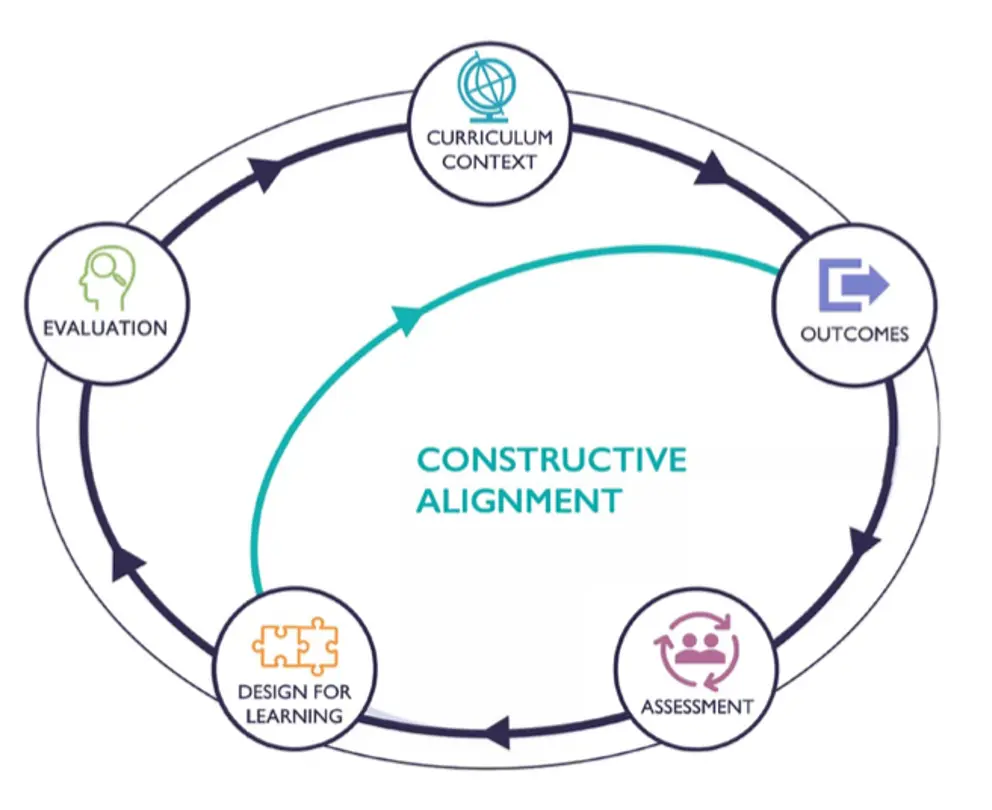About Evaluating Learning Experiences
This page explains the aim of evaluating learning experiences through course evaluations. It covers the purpose, benefits, and steps involved in conducting effective course evaluations to assess teaching quality, course content, and student learning outcomes. You will find out how course evaluations promote accountability, data-driven decision-making, and a student-centred approach.
What is Course Evaluation?
Course evaluation is a systematic process of gathering feedback from students about their learning experience in a particular course or module. It involves using surveys, questionnaires, or other evaluation instruments to collect quantitative and qualitative data from your students. The primary purpose of course evaluation is to assess the quality of the course, the effectiveness of the educator's teaching methods, and the overall educational experience.
Course evaluations can serve multiple purposes (LERU, 2021):
- Enhancing Teaching and Courses: The feedback obtained from students helps you identify areas for improvement in yor teaching practices, course content, and delivery methods. This information can be used to refine and enhance the course for future offerings.
- Faculty Development: Course evaluations provide valuable insights into your strengths and weaknesses, enabling you to receive constructive feedback and support for professional growth.
- Accountability and Transparency: Course evaluations promote transparency and accountability within educational institutions by providing a mechanism for students to voice their opinions and experiences.
- Student-Centred Approach: By actively seeking and considering student feedback, you demonstrate a commitment to a student-centred approach, valuing the perspectives and needs of your learners.
- Data-Driven Decision Making: The data collected through course evaluations can inform data-driven decision-making processes related to curriculum development, resource allocation, and institutional policies.
The purpose of evaluation is to improve, not prove.

What is Course Analysis?
Course analysis is the process where the course leader, together with the teaching team, critically examine and evaluate the effectiveness of a course based on various sources of information, including student feedback from course evaluations, assessment results, and personal teaching experiences.
The primary purpose of course analysis is to identify strengths, weaknesses, and areas for improvement in the course design, delivery, and overall learning experience. It involves a systematic review of the following aspects:
- Student Performance and Learning Outcomes: The teaching team analyses student performance data, such as grades, assessment results, and learning artefacts, to gauge the extent to which the intended learning outcomes were achieved.
- Student Feedback: Course evaluations and surveys provide valuable insights into students' perspectives on the course content, teaching methods, workload, and overall learning experience. This feedback is carefully considered during the analysis process.
- Teaching Strategies and Methods: The teaching team reflects on the effectiveness of the teaching approaches, instructional materials, and learning activities employed in the course.
- Course Structure and Content: The analysis examines the organisation, sequencing, and relevance of the course topics, as well as the alignment between course objectives, assessments, and learning activities.
- Learning Environment: The teaching team evaluates the impact of the physical or virtual learning environment, including factors such as classroom setup, technology integration, and online learning platforms.
- Resource Use: The analysis considers the appropriateness and effectiveness of the course resources, such as textbooks, readings, multimedia materials, and online resources.
By conducting a thorough course analysis, teaching teams can identify areas that require improvement or modification, as well as aspects that worked well and should be retained or enhanced. The findings from the course analysis inform future iterations of the course, leading to continuous improvement in teaching practices and student learning experiences.
Course analysis is an iterative process, with teaching teams revisiting and refining their analysis based on additional data or feedback from colleagues or educational developers. The insights gained from course analysis can also contribute to broader curriculum development and program evaluation efforts within the institution.

How Does Evaluating Learning Experiences Contribute to Quality?
Evaluating learning experiences through course evaluations and analysis plays a crucial role in ensuring and enhancing the quality of education provided by institutions. Here's how they contribute to quality:
- Continuous Improvement: Course evaluations and analysis provide valuable feedback and data that enable educators to identify areas for the continuous improvement in course design, delivery, and overall learning experience.
- Student-Centred Learning: By actively seeking and considering student feedback through course evaluations, educators demonstrate a commitment to a student-centred approach. This approach prioritises the needs, perspectives, and experiences of learners, ensuring that the educational offerings align with their expectations and learning preferences.
- Effective Teaching Practices: Course evaluations and analysis help instructors reflect on their teaching methods, identify strengths and weaknesses, adopt more effective pedagogical strategies, and engage in professional development.
- Curriculum Alignment: Evaluating learning experiences enables institutions to assess the alignment between course objectives, content, assessments, and learning activities. This analysis ensures that the curriculum is coherent, relevant, and aligned with the desired learning outcomes, contributing to the overall quality of the educational programme.
By actively evaluating learning experiences and using the insights gained from course evaluations and analysis, you can continuously improve the quality of your teaching and enhance student learning.
Many of us were educated within systems that housed traditional or standardized assessment and grading systems. As educators, we have all consciously or unconsciously based a grading policy or assessment practices on the modeling we learned as students. It can take a leap of faith to imagine new and innovative assessment practices — but we must rethink our notions of fairness and begin to think about developing practices that are equitable for the students in our care.
What about Anonymity?
KI recognises the vital role that anonymity plays in encouraging honest and open feedback from students during course evaluations. Providing candid assessments can be challenging for students, so it is our responsibility to create an environment where they feel comfortable expressing their genuine thoughts and experiences without any reservations (Scherer et al., 2013).
Anonymity is crucial for driving genuine improvements because it allows students to share their perspectives freely, without fear of potential repercussions or concerns about how their feedback might be perceived. By ensuring anonymity, we can assure students that their feedback will be treated with the utmost confidentiality and used constructively to enhance the quality of our educational offerings.
When students participate in course evaluations, their answers cannot be traced back to their names or identities. Their responses are completely anonymous, ensuring that they can provide honest and critical feedback without any hesitation or worry about being identified.
Honest feedback from students is the cornerstone of our continuous improvement efforts. It helps us identify areas that need attention, refine our teaching practices, and tailor our courses to better meet the learning needs of our students. Their candid assessments are invaluable in shaping a more engaging and effective learning experience for them and their peers. We must therefore encourage them to take advantage of this opportunity to share their perspectives, as their input plays a crucial role in shaping the future of our institution and enhancing the quality of education we provide.
As educators, it is our responsibility to foster an environment of trust and openness, where students feel empowered to provide honest feedback without fear of repercussions. By prioritising anonymity and treating their feedback with the utmost respect and confidentiality, we can create a culture of continuous improvement and ensure that our educational offerings remain aligned with the needs and expectations of our students.
